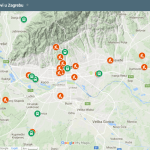After last year’s cosmetic work on the asphalt surface on the bridge the city has decided to work on the structural elements and railings of one of Zagreb’s busiest bridges.
The kerbstones have been falling out, the blocks have been falling out, the railing are mostly broken, and all this time the City officials kept announcing and then postponing the restoration works on the Most slobode (Freedom bridge, one of the oldest and busiest bridges across the Sava River in Zagreb, connecting the central part of Zagreb with the neighbourhoods south of the river near Bundek; so-called “Middle bridge” of the three major bridges in Zagreb). The people living near the bridge, in the Trnje neighbourhood have been warning the officials for years that the bridge was in a really bad condition overall, and it seems that their perseverance has finally paid off, as works on the foundation of the bridge and major structures on it have been announced. The bridge was originally built in 1959, designed by the famous Zagreb architect Krunoslav Tonković (and it is not his only bridge in Zagreb, as he has done a lot of work in the urbanisation of Zagreb in that period) and built partially from pieces of stone from the island of Brač, also used in the construction of the White House in Washington, some hundred and fifty years earlier.
In 59 years since the bridge has seen increasing car traffic, which has done a lot of damage to the construction elements, and it seems that the damage will finally be tackled, contained and fixed later this year, as a tender appears, trying to find the companies ready to fix the bridge. Among the works they are expected to perform are renovations of the pedestrian paths and railings, curbs and ditches, as well as the damaged sites on both the south and north access to the bridge. The tender specifies that around 19 million kuna will be invested in the bridge, and all of the works specified will have to be performed in a manner that will allow for the least possible disruption of the traffic over the bridge.
While the works are being performed the temporary regulation of traffic will be in place, so only two of the traffic lanes will be used for passenger cars, so we might as well get ready for long lines and hours of waiting to get over that (and, consequently, other Zagreb bridges). We still don’t know the exact date for this, as the tender closes on January 25th, so the earliest possible date for the beginning of this major restoration work is in March 2018, and the companies sending their proposals should be able to finish the work required in 6 months, at the longest. If that period shows to be too short to have the work done during work-hours only, we can expect to see some night or weekend shifts for the workers as well.








